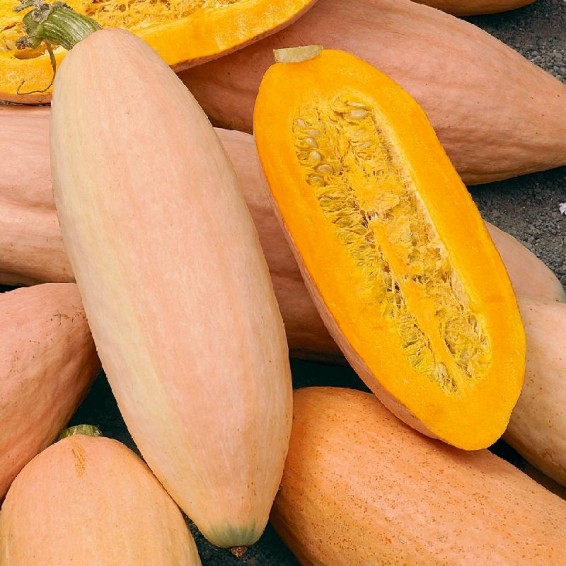Organic Pink Banana Winter Squash Seeds
- HOW TO GROW
- FAST FACTS
- REVIEWS
HOW TO GROW
Sowing: Gardeners with short growing seasons may want to start their squash seeds indoors a month before the last expected frost. Since squashes do not take well to transplanting, peat pots are the best option. Plant two seeds per pot, later clipping off the weaker seedling. Harden the seedlings by exposing them to the weather for several hours at a time during the week before transplanting. About a week after the last frost or when the soil temperature reaches an average of 60 degrees F, plant the seedlings in very rich soil 8-10' apart in rows 10-12' apart. Another option is to plant the seedlings in hills of two, 8-10' apart. To direct sow, plant the seeds a week after frost 1/2" deep, 3-4' apart and thin to 8-10' apart. For companion planting benefits, plant squashes along with corn but avoid planting them with potatoes.
Growing: Since squash seedlings do not tolerate frost, provide protective coverings if cold weather threatens. Keep the soil moist at all times, but avoid getting the leaves wet as this can cause diseases such as rot or mildew. When the vines begin to develop, a layer of mulch will help conserve moisture and control weeds; mulch also will keep the squashes clean and protect them from too much soil contact. By midsummer, pinch off all the blooms to concentrate the plant's energy on the developing squashes.
Harvesting: Squashes can be harvested as soon as the stem begins to dry and the skin becomes too hard to pierce with a fingernail. Because cold weather can damage squashes, they should be harvested before the first frost. Cut the stem with a sharp knife, leaving a 2-3" length." Do not carry the squash by the stem; if the stem breaks off, use it as soon as possible, since this causes the squash to deteriorate quickly. Cure the squashes in the sun or a dry location until the stem shrivels; do not wash the ones you intend to store.
Seed Saving: By the time the squash has been cured, the seeds are mature. Cut the squash open, remove the pulp and seeds, and rinse off the pulp. Put the mixture in a bowl of water to remove the remaining pulp; the good seeds will sink. Remove the good seeds and spread them out to dry for 2-3 weeks, stirring them at times to make sure they dry completely. Store the seeds in a cool, dry place for up to 4 years.
FAST FACTS
Latin Name: Cucurbita maxima
Type: Open Pollinated, Heirloom, Warm Season
USDA Zones: 3, 4, 5, 6, 7, 8, 9, 10, 11, 12
Seeds per Ounce: 130
Planting Method: Direct Sow
Sunlight: Full Sun
Height: 30 Inches
Color: Green
Great job
Premier packaging and fast shipping
DESCRIPTION
HOW TO GROW
Sowing: Gardeners with short growing seasons may want to start their squash seeds indoors a month before the last expected frost. Since squashes do not take well to transplanting, peat pots are the best option. Plant two seeds per pot, later clipping off the weaker seedling. Harden the seedlings by exposing them to the weather for several hours at a time during the week before transplanting. About a week after the last frost or when the soil temperature reaches an average of 60 degrees F, plant the seedlings in very rich soil 8-10' apart in rows 10-12' apart. Another option is to plant the seedlings in hills of two, 8-10' apart. To direct sow, plant the seeds a week after frost 1/2" deep, 3-4' apart and thin to 8-10' apart. For companion planting benefits, plant squashes along with corn but avoid planting them with potatoes.
Growing: Since squash seedlings do not tolerate frost, provide protective coverings if cold weather threatens. Keep the soil moist at all times, but avoid getting the leaves wet as this can cause diseases such as rot or mildew. When the vines begin to develop, a layer of mulch will help conserve moisture and control weeds; mulch also will keep the squashes clean and protect them from too much soil contact. By midsummer, pinch off all the blooms to concentrate the plant's energy on the developing squashes.
Harvesting: Squashes can be harvested as soon as the stem begins to dry and the skin becomes too hard to pierce with a fingernail. Because cold weather can damage squashes, they should be harvested before the first frost. Cut the stem with a sharp knife, leaving a 2-3" length." Do not carry the squash by the stem; if the stem breaks off, use it as soon as possible, since this causes the squash to deteriorate quickly. Cure the squashes in the sun or a dry location until the stem shrivels; do not wash the ones you intend to store.
Seed Saving: By the time the squash has been cured, the seeds are mature. Cut the squash open, remove the pulp and seeds, and rinse off the pulp. Put the mixture in a bowl of water to remove the remaining pulp; the good seeds will sink. Remove the good seeds and spread them out to dry for 2-3 weeks, stirring them at times to make sure they dry completely. Store the seeds in a cool, dry place for up to 4 years.
FAST FACTS
Latin Name: Cucurbita maxima
Type: Open Pollinated, Heirloom, Warm Season
USDA Zones: 3, 4, 5, 6, 7, 8, 9, 10, 11, 12
Seeds per Ounce: 130
Planting Method: Direct Sow
Sunlight: Full Sun
Height: 30 Inches
Color: Green
Reviews
Review
Great job
Premier packaging and fast shipping





